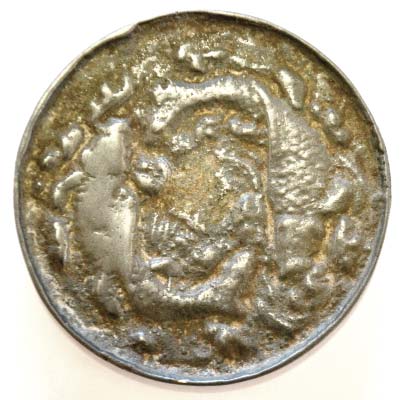GOLDEN HORDE MIRROR DISCOVERED IN THE IK RIVER BASIN
DOI:
https://doi.org/10.24852/2587-6112.2020.6.379.386Keywords:
archaeological finds, bronze mirrors, images of two carps among seaweed and flowers, China in Song and Jin eras, the Great Silk Road, the Golden Horde period, medieval ceramics, Ik river basin, medieval monumentsAbstract
The publication characterizes an archeological fi nd discovered on the left riverbank of the Ik river in the vicinity of Sarly village in Aznakayevsky district of the Republic of Tatarstan. The discovered unique bronze mirror with the image of two carps frolicking among seaweed is analyzed. The authors reveal the symbolism of this image as a sign of abundance and material well-being, promising happiness, prosperity, wealth and harmony, as a benevolent symbol of numerous offsprings. The image of a carp becomes the embodiment of persistence in the achievement of goals, a wish of successful career and general success in life. Images of mirrors with two fi sh were typical of medieval China. Similar images on various items (mirrors, ware and others) with pair carps appeared in the Volga-Ural region during the Golden Horde period. Whole mirrors are unique fi nds for this region and are most likely connected with a destroyed burial.
References
Alekseev, V. P. 1958. V starom Kitae. Dnevniki puteshestviia 1907 g. (Ancient China. Travel Notes of 1907.). Moscow: “Vostochnaya literatura” Publ. (in Russian).
Arslanova, F. Kh., 1970. In Kadyrbaev, M. K. (ed.). Po sledam drevnikh kul’tur Kazakhstana (In the Footsteps of the Ancient Cultures of Kazakhstan). Alma-Ata: “Nauka” Publ., 54−59 (in Russian).
Burkhanov, A. A., Mukhametshin, D. G. 2014. Ocherki istorii Yugo-Vostochnogo Tatrstana (Essays on the History of South-Eastern Tatarstan). Kazan: “Yaz” Publ. (in Russian).
Burkhanov, A. A., Nigamatzianov, I. R. 2017. Drevnosti Vostochnogo Zakam’ia (Antiquities of the Eastern Trans-Kama Region). Kazan: Institute of History named after Shigabuddin Mardzhani, Tatarstan Academy of Sciences (in Russian).
Vasil’ev, L. S. 1988. Istoriia religii Vostoka (History of Religions of the East). Moscow: “ Vysshaia shkola” Publ. (in Russian).
Garistovich, G. N., Ivanov, V. A. 2014. Materialy po arkheologii srednevekovykh kochavnikov Yuzhnogo Urala (IX – XV vv. N.e.) (Materials on the Archaeology of the Medieval Nomads of the Southern Urals (9th-15th centuries AD)). Ufa: Bashkir State University (in Russian).
Zakharova, I. V., Zakharov, V. Yu. 2010. Udacha po-kitaiski: kak chitat' iazyk simvolov (Luck in Chinese: How to Read Symbol Language). Rostov on Don; Krasnodar: “Feniks” Publ., “Neoglori” Publ. (in Russian).
Izmailov, I. L. 2000. In Problemy izuceniia zaseleniia i obrazovaniia naselennykh punktov Al’met’evskogo regiona (Issues of the Studies of the Settling and Formation of Settlements in Almetyevsk Region). Kazan: “Master-Line” Publ., 16–28 (in Russian).
Izmailov, I. L. 2002. In Kul’pin, E. S. (ed.). Priroda I samoorganizatsiia obshchestva (The Nature and Self-Organization of the Society). Moscow: “Moskovskii litsei” Publ., 226−238 (in Russian).
Kazakov, E. P. 1978. Pamiatniki bolgarskogo vremeni v vostochnykh raionakh Tatarii (Sites of Bulgarian Time in the Eastern Parts of Tataria). Moscow: “Nauka” Publ. (in Russian).
Lubo-Lesnichenko, E. I. 1975. Privoznye zerkala Minusinskoy kotloviny. K voprosu o vneshnikh svyazyakh drevnego naseleniya Yuzhnoy Sibiri (Imported Mirrors of the Minusinsk Basin. The Issue of External Relations of the Ancient Population of South Siberia). Moscow: “Nauka” Publ. (in Russian).
Mayavkin, V. V. 2000. Kitaiskaya tsivilizatsii (The Chinese Civilization). Moscow: “Dizain. Informatsiia. Kartografi ia” Publ. (in Russian).
Nabiullin, N. G. 2011. Dzhuketau – gorod bulgar na Kame (Juketau, a Town of the Bulgars on the Kama River). Kazan: “Tatarskoe knizhnoe izdatel’stvo” Publ. (in Russian).
Nedashkovskii, L. F., Rakushin, A. I. 1998. In Tatarskaia arkheologiya (Tatar Archaeology) 3(2), 87–108 (in Russian).
Fedorov-Davydov, G. A. 1994. Zolotoordynskie goroda Povolzh’ia (Golden Horde Towns in the Volga Area). Moscow: Moscow State University (in Russian).
Fedorov-Davydov, G. A. 1966. Kochevniki Vostochnoi Evropy pod vlast’iu zolotoordynskikh khanov: Arkheologicheskie pamiatniki (East-European Nomads under the Golden Horde’s Khans: Archaeological Sites). Moscow: Moscow State University (in Russian).
Khuan Yan’shen’, Chen’Yui. 2014. Pamjatniki kul'tury epokh dinastii Sun – Yuan' (Cultural Monuments of the Song-Yuan Dynasties). Beijing; Moscow: “Shans” Publ. (in Russian).
Yuan Ke, 1965. Mify Drevnego Kitaia (Ancient Chinese Myths). Moscow: “Nauka” (in Russian).

Downloads
Published
How to Cite
Issue
Section
License
Copyright (c) 2020 A.A. Burkhanov, I.L. Izmailov, Ch.Z. Rakhmatullina

This work is licensed under a Creative Commons Attribution-NonCommercial 4.0 International License.







